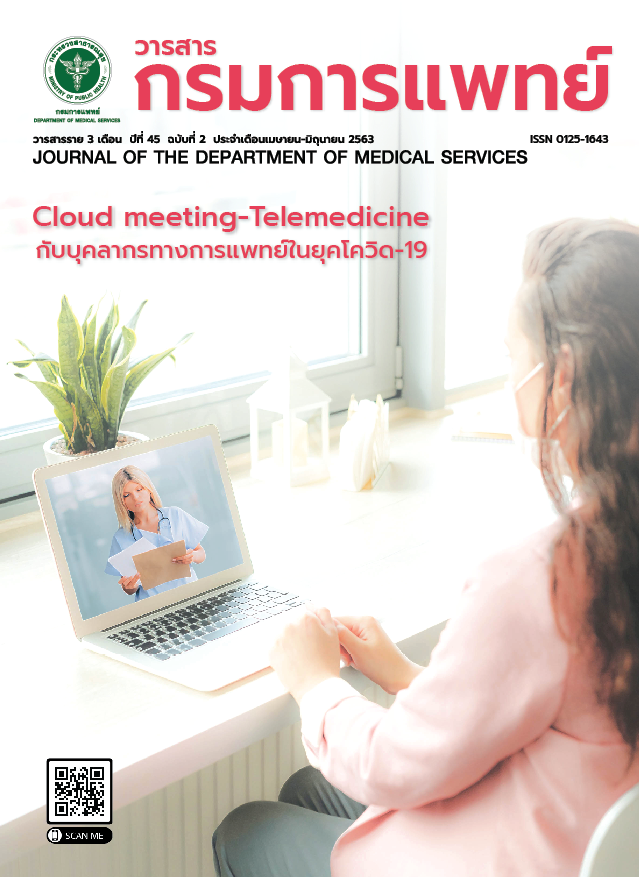Uvula injury in Tonsillectomy: A Comparative Study between the Use of Gauze to Hold the Uvula and Conventional Method in Yasothon Hospital
Keywords:
Uvula protection gauze, Tonsillectomy, Reduction of injury of uvulaAbstract
Background: Tonsillectomy is one of the most common surgeries performed in ear, nose and throat patients. However, all surgeons feel uncomfortable with uvula due to uvula shaded the operation. Injury of uvula will be occurred by suction and electric cautery and it will affect to operation. This research studied and created the uvula protection gauze to hold the uvula during operation.
Objective: To study efficacy of the use of gauze to hold the uvula during tonsillectomy in reducing injury of the uvula.
Method: Non-randomized controlled trial was used in this study during 1st January 2018 and 9th June 2019. There were 2 groups of patients. The first group was the experiment group (E group), all patients used the gauze to protect uvula during tonsillectomy. The second group was the control group (C group) used the conventional method without the use of gauze. The levels of uvula trauma were recorded as level 0 to 3 : 0- no injury; 1- uvula swelling and redness below 1/3 of length of uvula; 2- same as 1 but more than 1/3 of length of uvula; 3- evidences electric cautery. The data such as the number of uvula injury from the suctions and electric cautery including the level of uvula trauma were analyzed by statistic.
Results: All 117 patients undergoing tonsillectomy were enrolled to the study. The experimental group (E group) was 70 patients, 31 men and 39 women with their ages ranging from 4 to 53 years. The control group (C group) consisted of 42 patients, 27 men and 15 women with their ages ranging from 3 to 38 years. The average times used the gauze to protect uvula were 2.8 minutes. The average operative times in both groups were 21 minutes in E group and 22.7 minutes in C group. The number of patients with uvula injuries from suction and electric cautery was 0 (0%) in E group and 33 (78.57%) in C group. The most frequencies of suction use were 5-6 times in the operation. The number of the uvula injuries from electric cautery was 0 patient (0%) in E group and 5 patients (11.9 %) in C group. The levels of uvula injuries after operation were found as level 0 and 1 (81% and 13%) in E group and level 0,1,2,3 (21.43%, 38.10%, 28.75% and 11.9% respectively) in C group. This study showed that there were statistically significant differences in E group and C group between the number of uvula injuries from the suctions and electric cautery and also the level of uvula trauma that p-values were 0.000, 0.003 and 0.000, respectively.
Conclusion: There were statistically significant differences of the use of gauze to hold the uvula during tonsillectomy in reducing the uvula injury.
References
Goldstein NA. Evaluation and management of pediatric obstructive sleep apnea. In: Flint P, Haughey B, Lund V, editors. Cummings Otolaryngology Head and Neck Surgery. 6th ed. Philadelphia: Elsevier; 2015. P 2854-64.
Brodsky L Poje C. T onsillitis ,tonsillectomy and adenoidectomy. In: Bailey BJ, Johnson JT, Newlands SD, editors. Head and Neck Surgery –Otolaryngology. 4th ed. Philadelphia: Courier-Kendallville; 2006. P 1183-98.
Isaacson G. Tonsillectomy care for the pediatrician. Pediatrics 2012; 130:324-34.
Baugh RF, Archer SM, Mitchell RB, Rosenfeld RM, Amin R. Clinical practice guideline: tonsillectomy in children.Otolaryngol Head Neck Surg 2011;144:1-30.
Messner AH. Tonsillectomy. Oper Tech Otolaryngol 2005; 16:224-8.
Walton J, Ebner Y, Stewart MG, April MM. Systematic review of randomized controlled trials comparing intracapsular tonsillectomy with total tonsillectomy in a pediatric population. Arch Otolaryngol—Head Neck Surg 2012;138: 243-9.
Kathryn M, Abel V , Moore EJ. Transoral approaches to malignant neoplasms of the oropharynx. In: Flint P, Haughey B, Lund V , editors. Cummings Otolaryngology Head and Neck Surgery .6th ed. Philadelphia: Elsevier; 2015. P 1454-78.
Gallagher TQ, Wilcox L, McGuire E , Derkay CS. Analyzing factors associated with major complications after adenotonsillectomy in 4776 patients: comparing three tonsillectomy techniques. Otolaryngol Head Neck Surg 2010;142:886-92.
Magdy EA, Elwany S, Daly AS , Hadi MA , Morshedy MA. Clobation tonsillectomy: a prospective, double-blind.Randomized, clinical and histopathological comparision with dissection-ligation , monopolar electrocautery and laser tonsillectomy. J Laryngol Otol 2008;122:282-90.
Pamnani A , Faggiani SL , Hood M , Kacker A , Gadalla F. Uvula injury during the perioperative period in patients undergoing general anesthesia. Laryngoscope 2014; 124:196-200.
Kinthala S, Areti YK. Airway obstruction and inability to ventilate due to swollen uvula following adenotonsillectomy in a three-year old child. West Indian Med J 2014; 63:211-12.
Tabboush ZS. Airway obstruction from uvula edema after traumatic adenoidectomy. Anesth Analg 2000; 91:494.
Nasr VG, Bitar MA , Chehade JM , Dagher WI , Baraka AS. Post-operative severe uvula edema following tonsillectomy in a child with a history of obstructive sleep apnea. Paediatr Aneasth 2008; 18:673-5.
Arigliani M, Dolcemascolo V, Passone E ,Vergin M , Cogo P. Uvula trauma after laryngeal mask airway use. J Pediatr 2016; 176:217.
Alajmi MA, Noumas HS, Abdulhadi KA , Kavitha G. Steroids for reducing post tonsillectomy morbidity. Kuwait Med J 2008;40:211-5.
Calikapan GT, Karakus F .Uvula necrosis after endotracheal intubation for rhinoplasty. Anesthetic Plast Surg 2008; 32: 710-11.
Evans DP, Lo BM .Uvula necrosis after orotracheal intubation. Am J Emerg Med 2009; 27:631.
Downloads
Published
How to Cite
Issue
Section
License
บทความที่ได้รับการตีพิมพ์เป็นลิขสิทธิ์ของกรมการแพทย์ กระทรวงสาธารณสุข
ข้อความและข้อคิดเห็นต่างๆ เป็นของผู้เขียนบทความ ไม่ใช่ความเห็นของกองบรรณาธิการหรือของวารสารกรมการแพทย์



